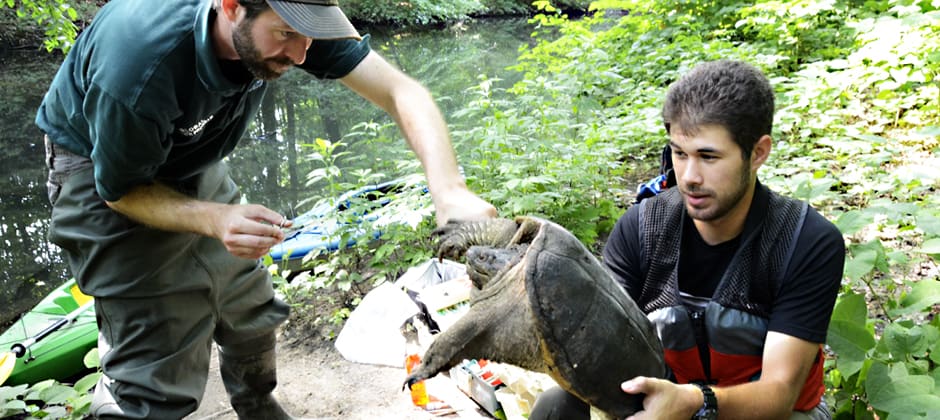Share this article
Bronx River turtles persist, despite pollution
Hundreds of years ago, the Bronx River was rife with aquatic reptiles like common snapping turtles, musk turtles and painted turtles.
But only a few species have managed to survive centuries of heavy development and pollution in the Bronx, one of the U.S.’ densest urban areas. And just like the city’s human population, many of its current turtle inhabitants are immigrants from elsewhere.
Researchers monitoring turtle populations in New York’s Bronx River found common snapping turtles (Chelydra serpentina) that had likely lived to be decades old. A large number of nonnative red-eared sliders (Trachemys scripta elegans), a species that originally hails from across the Southeastern U.S., occupied the river, but many native species were nowhere to be found.
“It’s pretty cool that the Bronx Park has been preserved since major development started,” said Valorie Titus, an assistant professor in wildlife biology at Keystone College in Pennsylvania and one of the co-authors of a study published recently in The Journal of Wildlife Diseases. Raymond Ditmars, a curator at the Bronx Zoo, which lies in the Bronx Park, had recorded historical information on the turtles in the river. Titus wanted to update these surveys.
She and her colleagues surveyed a section of the Bronx River in 2012 to understand the state of turtle diversity there. This part of the waterway winds through the New York Botanical Garden and the Bronx Zoo, more or less retaining the wandering trajectory it would have had centuries before the introduction of subways and skyscrapers.
“There are a couple waterfalls that have been put in there for electricity generation but, for the most part, it meanders quite nicely,” Titus said.
But the river is still polluted, she said, and it becomes brackish as it opens into Long Island Sound, where heavy boat traffic presents an additional danger to turtles.
She and her colleagues found only three species — native snappers, a single native painted turtle (Chrysemys picta) and the nonnative sliders. Several of the snapping turtles weighed 20 to 30 pounds, indicating that the reptiles, which can live to be 90, were quite old, even though specific ages couldn’t be determined. The lone painted turtle was unhealthy, Titus said, and the turtles they found generally had high levels of arsenic, mercury, selenium and lead.
Researchers also found the snapping turtles had a unique strain of mycoplasmosis, but since the bacterial respiratory disease occurs naturally in many turtle and tortoise species even in more wild areas, it was unclear whether the polluted waters played a role.
The large number of red-eared sliders speaks to the nonnative species’ ability to survive in adverse conditions alongside humans, she said, while the absence of species like common map turtles (Graptemys geographica) and musk turtles, (Sternotherus odoratus) which are commonly found in New York state waterways elsewhere, shows that these native species may be more sensitive pollution and human disturbance.
Titus said further research is needed to determine the specific reasons for this imbalance between native and nonnative turtle species. She hopes to go back in 2022 to perform a 10-year follow up on turtle diversity in the area.
Header Image:
A team of scientists and veterinarians evaluate the health of turtles living in the Bronx River.
©Julie Larsen Maher/WCS








